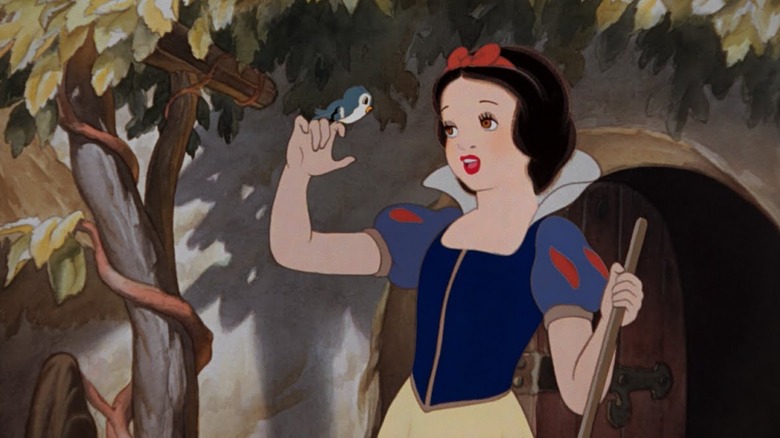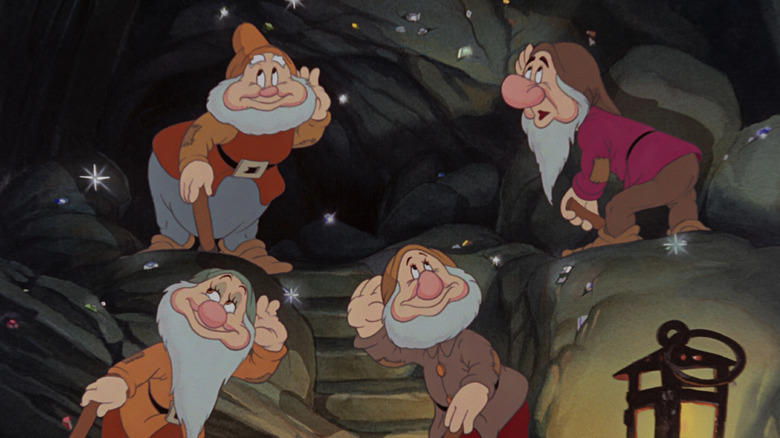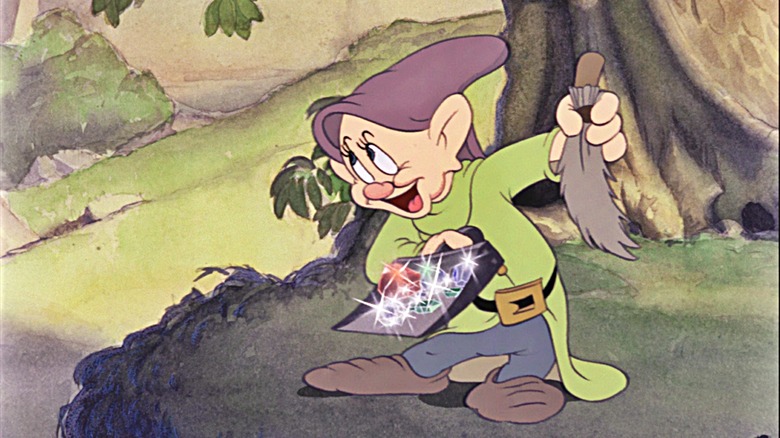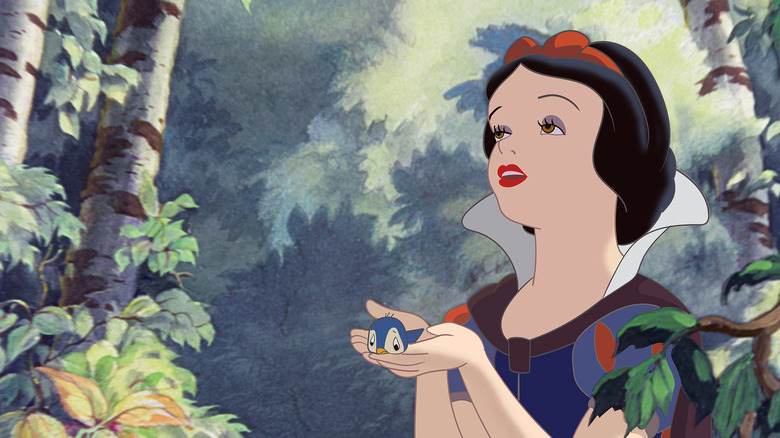The NSFW Inspiration Behind Snow White's Lost Soup Sequence
By 1937, the Walt Disney animation studio had already established itself as a power player in the medium. The studio had already won five Academy Awards for its short films — "Flowers and Trees" in '31/'32, "The Three Little Pigs" in '32/'33, "The Tortoise and the Hare" in '33/'34, "The Orphan Kittens" in 1935, and "The Country Cousins" in 1936 — and was about to release its very first feature-length animated film, a coup in terms of the studio's creative output. In the spirit of their higher-profile nursery-rhyme-inspired shorts, "Snow White and the Seven Dwarfs," directed by David Hand, with sequences directed by William Cottrell, Wilfred Jackson, Larry Morey, Perce Pearce, and Ben Sharpsteen, would be derived from a fairy tale and would feature a good deal of singing. The Seven Dwarfs of the title would be animated in the traditional way — freestyle by hand — and Snow White would be animated via rotoscope; that is: Actress Marge Champion would enact the character's movements on film, and the studio's animators would paint over her. Singer and vocalist Andriana Caselotti would provide Snow White's voice.
"Snow White" was an enormous hit and won a special Academy Award for "Screening innovation" in 1937 (The Best Animated Feature category wouldn't be implemented until 2001). It has since gone on to become the bedrock of many Disney animated films made to this day: Established fairy tales, mostly of European origin, with a heroic woman at the center. Snow White, the character, would eventually be included in a canon of "Disney Princesses" when the official distaff brand was first released in January of 2000 (she would be seen on merchandise next to Cinderella, Belle from "Beauty and the Beast," and other protagonists from decades worth of Disney animated features). "Snow White" was not, as Disney has claimed in the past, the very first animated feature film — that honor belongs to the 1917 Argentinian film "El Apóstol" which is, sadly, lost. The earliest animated feature film still surviving is Lotte Reiniger's "The Adventures of Prince Achmed" (1926) which is currently available on The Criterion Channel and Kanopy. And despite the film's wholesome reputation, there's a deleted scene involving soup that you might not be aware of. And it has a surprisingly risque origin story, at least for Disney.
The Soup Sequence
The story of "Snow White and the Seven Dwarfs" involves a young woman, so named for her pale complexion, who is being raised by her stepmother, a vain queen with a magic mirror who daily informs her that she is the most beautiful woman alive. When the mirror tells the queen that Snow White has unexpectedly surpassed her, she tries to have Snow White assassinated. The assassin, instead, abandons Snow White in the woods where she moves in with seven elderly miners. Using her experiences as a scullery maid, she cleans up their home and becomes an ersatz mother to them. While living with the miners, Snow White sings pleasant songs to them, and they respond with aw-shucks enthusiasm to have her as their roommate.
In a deleted sequence, Snow White has prepared a vat of soup for the miners, and they sing a song, "Music in Your Soup" about what a pleasant meal it is. The sequence was never inked and painted and the only animation that survives is the pencil test, but the test has been rediscovered, cleaned up, and released in a 4K restoration. In the sequence, the characters slurp in time to the music and display increasingly creative ways to imbibe their soup before Snow White cheerily instructs them how to use spoons. Echoes of the soup sequence can be seen decades later in the porridge scene in Gary Trousdale and Kirk Wise's "Beauty and the Beast" from 1991. The sequence ends with a comedic set piece wherein the miners have to extricate an accidentally swallowed spoon from the throat of one of their compatriots.
The sequence is affable and lightly funny without being hilarious — typical for Disney animation — and lasts about four minutes. It's easy to see why it was cut
Dopey's Burleqsue
One of the seven dwarfs is named Dopey — the dwarf's names are extrapolated from their most dominant personality traits — and he is a silent, elf-like creature with ill-fitting clothes and a comedic way of moving. Dopey flails a lot, making him a triumph of character animation. Oscar-winning animator (and legend in the medium) Ward Kimball was one of the chief animators at Disney in 1937, and in a 2016 interview with The New England Review, he reminisced about the making of "Snow White and the Seven Dwarfs," the careful and rigorous production, and the unconventional inspiration for the movements of Dopey.
The Disney animation offices were located in Burbank, CA, and many of the people working there at the time, according to Kimball, were young single men. It was a regular practice for the animation crew to clock out for the day and retire to one of L.A.'s many nudie theaters and burlesque halls to unwind with a strip show. Kimball remembers The Burbank in particular, a building located at 548 S. Main St. in downtown Los Angeles that was both a movie house and a burlesque theater. Burlesque shows in the 1930s traditionally included strippers (not necessarily nude dancers, depending on the venue), raunchy comedians, and other bawdy, wild, or just silly acts. It was a whole evening of adult entertainment. Kimball recalls seeing a comedian at The Burbank named Eddie Collins who often wore oversized suits, flailed his body about in an exaggerated fashion, all while ogling lasciviously at the venue's dancers. Kimball was particularly impressed with Eddie Collins' tongue, which he described as being 12 inches long.
Kimball told one of "Snow White"'s directors, Ben Sharpsteen, to attend the show to see Eddie Collins do his act. Kimball claims Sharpsteen was embarrassed to be taking animation notes at a girly show, but the story goes that Sharpsteen was so impressed, that he hired Eddie Collins to act as a movement model for the "Show White" soup sequence. Collins would also end up being hired to provide vocalization for Dopey as well. After "Snow White" Collins would also go onto a varied film career playing character roles in high-end studio productions like the Oscar-nominated "In Old Chicago," the Shirley Temple Vehicle "The Blue Bird" (in which Collins played a dog transformed into a man), and John Ford's "Young Mr. Lincoln."
Smut and Comics
Disney animated features — typically sex-free and lacking edge — infused the medium with a family-friendly quality to the point where, in the present day, the name "Disney" is often easily conflated with "kid-friendly." Thanks to its powerfully successful branding of the human subconscious, Disney is not so much a studio as it is a genre: High-quality, inoffensive entertainment for kids. The Disney image is so squeaky-clean, that a story of burlesque dancers working their way into animated features seems like a subversive little secret (not to mention the myriad rumors of animators making pornographic films for themselves, or the sneaky appearance of sexual coding in various features; the priest's visible arousal in "The Little Mermaid," the word "SEX" in a dust cloud in "The Lion King," etc.).
But the truth of the matter is animators and illustrators frequently refer to nude photographs, dancers, and even pornography to more explicitly capture human anatomy. This knowledge comes largely from anecdotal evidence; it's hard to find Disney animators going on record with their naked inspirations. But when it comes to human movements and bodily accuracy, nudity and sexuality are typically included in sketches, animation, inking, and other illustrated media. So if you're watching a Disney animated film from the 1930s, and the characters look like they belong in a burlesque hall, it's no coincidence.



